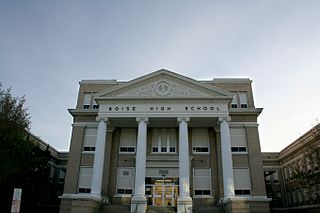
Boise High School is a public secondary school in Boise, Idaho, one of five traditional high schools within the city limits, four of which are in the Boise School District. A three-year comprehensive high school, Boise High is located on the outlying edge of the city's downtown business core. The enrollment for the 2014–15 school year was approximately 1,481.
The following is a timeline of the history of the city of Boise, Idaho, United States.

Walter E. Pierce was a prominent real estate speculator in Boise City, Idaho, USA, in the late 19th century and in the first half of the 20th century. Pierce served as mayor of Boise City 1895-97 as it evolved from being a frontier community to being a modern town.
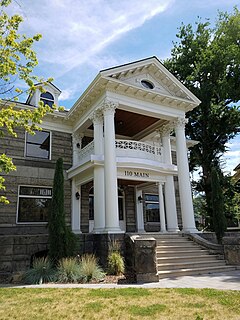
The West Warm Springs Historic District in Boise, Idaho, is a neighborhood of homes of some of Boise's prominent citizens of the late 19th and early 20th centuries. Roughly bounded by W Main St, W Idaho St, N 1st St, and N 2nd St, the district was added to the National Register of Historic Places in 1977 and included 14 properties. Of these original resources, 11 remain in the district.
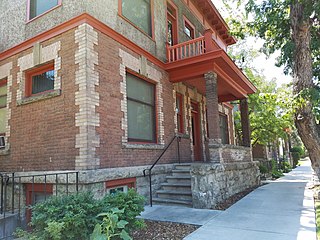
The Eichelberger Apartments in Boise, Idaho, is a 2-story, Colonial Revival building designed by Tourtellotte & Hummel and constructed in 1910. The U-shape, brick and stucco design features corner quoins and keystoned windows with a roofline parapet covered between crested pilasters. It was included as a contributing property in the Fort Street Historic District on November 12, 1982. The building was individually listed on the National Register of Historic Places on November 17, 1982.

The Lower Main Street Commercial Historic District in Boise, Idaho, is a collection of 11 masonry buildings, originally 14 buildings, that were constructed 1897-1914 as Boise became a metropolitan community. Hannifin's Cigar Store is the oldest business in the district (1922), and it operates in the oldest building in the district (1897). The only building listed as an intrusion in the district is the Safari Motor Inn (1966), formerly the Hotel Grand (1914).

The Cyrus Jacobs House, also known as the Cyrus Jacobs-Uberuaga House and the Basque Museum and Cultural Center, in Boise, Idaho, is a 1 1⁄2-story brick house constructed by Charles May in 1864. The house was added to the National Register of Historic Places in 1972.

Cyrus Y. Jacobs was a grain mill owner, distiller, and merchant in Boise, Idaho. He served as mayor of Boise City 1879-1880.

The Belgravia Building in Boise, Idaho, is a 2-story, sandstone and brick structure designed and built by John S. Jellison as a set of apartments in the Romanesque Revival style in 1904. Originally known as DuBois Flats and later as Belgravia Terraces, the building was a subject of litigation shortly before its scheduled opening in September 1904, and legal disputes over payment of construction costs delayed the opening until June 1906.

The Emerson and Lucretia Sensenig House, also known as the Marjorie Vogel House, is a 2 1⁄2-story Foursquare house in Boise, Idaho, designed by Watson Vernon and constructed in 1905. The house features a hip roof with centered dormers and a half hip roof over a prominent, wraparound porch. Porch and first-floor walls are brick, and second-floor walls are covered with square shingle veneer. A second-story shadow box with four posts is inset to the left of a Palladian style window, emphasized by three curved rows of shingles. The house was added to the National Register of Historic Places in 1997.
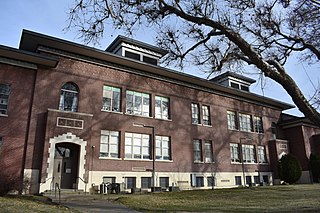
Garfield School in Boise, Idaho, is a 2-story, flat roof brick building designed by Tourtellotte & Hummel and constructed in 1929. The 1929 facade is symmetrical and shows a Tudor Revival influence, and shallow arch entries at north and south ends of the building are prominent features of the Broadway Avenue exposure. The brick cornice is inset with a diamond pattern. In 1949 the elementary school was expanded with north and south wings containing additional classrooms and an auditorium. The expansion is compatible with the original structure, and the building was listed on the National Register of Historic Places in 1982.

The William Whitehead House, also known as Hillview Ranch, in Boise, Idaho, is a 1 1⁄2-story Bungalow designed by Tourtellotte & Hummel and constructed in 1910. The house includes a cross gable, overhanging roof supported by decorative knee braces. Rafter tails are exposed under the eaves, and verge boards are decorated with half-moon cutouts. The house was added to the National Register of Historic Places (NRHP) in 2016.

The Albert Beck House in Boise, Idaho, is a 1 1⁄2-story Queen Anne house designed by Tourtellotte & Co. and constructed in 1904. The house features sandstone veneer on its first floor walls and on a wrap around porch. Overhanging gables with dimpled dormer vents were prominent at the Fort Street and 11th Street exposures. The house was added to the National Register of Historic Places in 1982.

The Joseph Bown House in Boise, Idaho, is a two-story Italianate house constructed of sandstone in 1879. The house was added to the National Register of Historic Places (NRHP) in 1979.
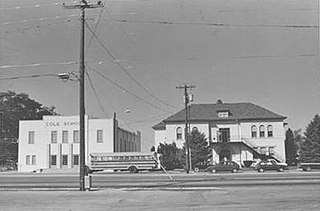
Cole School and Gymnasium in Boise, Idaho, was a 2-story, stucco over brick school building with stone trim. The year of construction was likely 1903, although in an annual report issued by the Boise School District 1972–73, the year was given as 1908. Above the main entry of a 1951 addition to the building was written, "Cole Elementary Est. 1888." The buildings were added to the National Register of Historic Places (NRHP) in 1982.

Franklin School in Boise, Idaho, was a 2-story, brick and stucco building designed by Tourtellotte & Hummel and constructed in 1926. The school featured a flat roof with a decorated concrete parapet. The school was added to the National Register of Historic Places (NRHP) in 1982. In 2009 the building was demolished.

The Clara Hill House in Meridian, Idaho, is a 1 1⁄2-story Craftsman Bungalow constructed in 1919–20. The house features an enclosed porch facing North Main Street, with a front facing gabled dormer above and behind the porch. The lateral ridgebeam extends beyond left and right dormered gables. First floor exterior walls are clad in weatherboard, and gable walls are covered in wood shingles. The house was added to the National Register of Historic Places in 2006.

The Charles and Martha Villeneuve House, also known as the Herridge House, near Eagle, Idaho, is a 1 1⁄2-story Queen Anne house constructed of cobblestones from the Boise River in 1881. Ground floor stone walls are 12-14 inches thick, and the upper half story construction is wood frame with front and left side gables. A 1961 addition at the rear of the house is not visible from Moon Valley Road. The house was added to the National Register of Historic Places in 1990.

Star Camp in Star, Idaho, also known as Friends Community Center, is a meeting facility and tabernacle operated by Quakers and constructed in 1949. The facility is part of a 5-acre parcel organized as a camp meeting area in 1941.




















